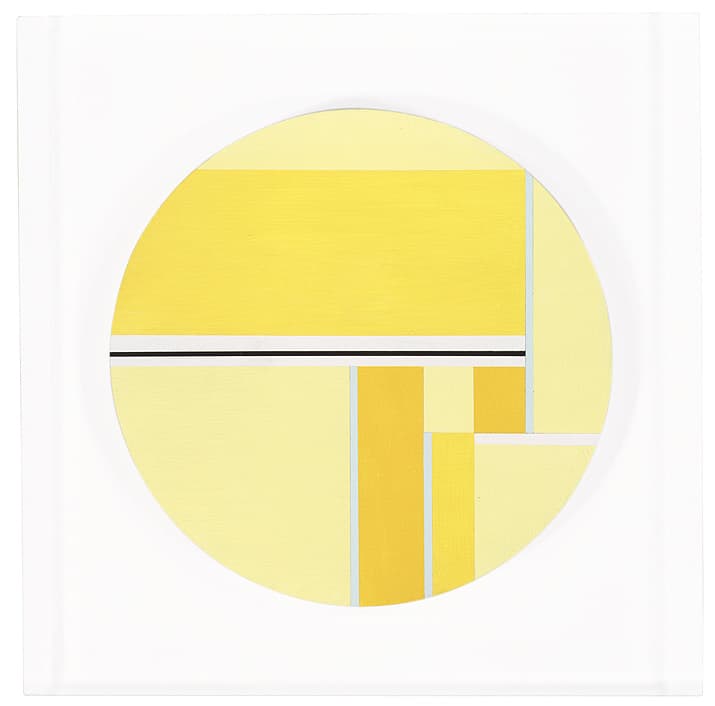
Ilya Bolotowsky
We Are Actively Seeking Paintings By Ilya Bolotowsky
Click To Get A Valuation Of Your Ilya Bolotowsky Painting. You’ll get a confidential fair market valuation of your painting and its marketability. We pay cash for paintings by Ilya Bolotowsky and take consignments to the gallery.

Ilya Bolotowsky (1976)
Yellow Tondo
Oil on wood, 8 x 8 inches
Ilya Bolotowsky Biography
Ilya Bolotowsky (1907 – 1981)
Ilya Bolotowsky was born in St. Petersburg, Russia in 1907. At the age of 10, he and his family fled the Russian Revolution of 1917 to Istanbul. They remained there until 1923 when they moved to the United States.
His mother was a self-taught artist. His tutors encouraged his art and he explored his artistic side from an early age. At 17 he assimilated into New York life while attending the National Academy of Design. He studied alongside Ivan Olinsky, another ex-Russian immigrant who became a well known artist.
The Academy was a conservative place in the 1920’s. Artists such as Mark Rothko and Adolph Gottlieb railed against the rules and pretentiousness of the institution. They held independent exhibitions and displayed their ground-breaking abstract and expressionist art. Ilya Bolotowsky was among them, having gained a taste for unusual abstract art.
The early artwork of Ilya Bolotowsky is an attempt at cubism. Those paintings were influenced by the “constructivism” of his homeland and the “synthetic” cubism he encountered in the USA. Consisting of mild, minor colors in geometric and geomorphic shapes in a flat plane, it is clear he was experimenting with the styles of others while trying to create his own. These early works are passable and show a definite direction and his characteristic simplicity. But they lack the sophistication that came later.
In 1933 Ilya Bolotowsky saw paintings by Piet Mondrian in the Gallatin Collection in New York. This was a major influence on the young Bolotowsky, who loved the simple, clear and confounding abstraction of Mondrian’s artwork. This was art at its most controlled yet at its most elemental, it was the style of De Stijl. Ilya Bolotowsky’s art evolved into what Mondrian came to term “neoplasticism”, a “pure representation of the human mind … aesthetically purified, that is to say, abstract …”.
Ilya Bolotowsky took on several rules for his abstraction. For example, not using diagonals because it disrupted the harmony of the spatial tension he desired to create. He also avoided right angles when possible, feeling them disharmonious. He said “I strive after an ideal of harmony”, and this is clear to the observer. His compositions are well balanced and meticulously designed. They break out of the constraints of the De Stijl school and were created with muted colors and textures in a way that was quite out of the ordinary.
World War II interrupted the lives of nearly everyone on the planet, Ilya Bolotowsky included. He worked as a translator for the Military and later as a liaison between the Soviet Air Force and the Americans. When his service ended, he headed back to New York to his parent’s apartment and took up painting. He continued as if he had only stepped out for lunch. Shortly after his return, he got a one-man show at the New Art Circle, which was successful. As many artists did at the time, he took a job as a teacher, then as a professor of art. He experimented in films, winning awards and applying his unique simplicity and insight.
By the age of 40, Ilya Bolotowsky was hitting his stride. Forgoing the traditional square canvas for shapes that contributed to the geometry of the design on or inside them. There is a gradual saturation of his work as well, the muted colors and shapes transforming into bolder, brighter designs. Always one to take on new influences and directions, the abstract expressionists of the 1950’s brought out a confrontational style in Ilya Bolotowsky and his works became more stand-out and vibrant in their abstraction. They utilize clashing colors, larger shapes and a more varied palate. This era of Ilya Bolotowsky is very popular with collectors and artists alike.
Ilya Bolotowsky continued to grow and evolve and seek purer expression and purpose in his art. He remained distinctive in his style, never throwing it away to start anew, always modifying and evolving. In the early 1960’s, Bolotowsky took his primary color palate and started applying it to models and shapes. He experimented with the power of geometry and color as an expressive tool. Stripped of “human” identity, his paintings have an “aliveness” and vibrancy that make them immediately distinct from many of his contemporaries and those that sought to copy him. Bolotowsky’s paintings are remarkably human.
As the popularity of his work increased, and the styles of abstract expressionism made it into the mainstream, his art went from being confrontational and confounding to being something people would decorate their houses with. Ilya Bolotowsky’s artwork is immediately recognizable as art and not decoration. But its uniqueness was lost to an extent. Perhaps because the imitation of his designs was so pervasive.
Ilya Bolotowsky died in 1981 at the age of 74.